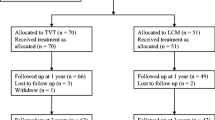Abstract
Introduction and hypothesis
The aim of this study is to provide long-term outcome data, at least 10 years, following laparoscopic colposuspension.
Methods
The study includes a control group who underwent open colposuspension. A consecutive series of 139 women who had undergone laparoscopic colposuspension were reviewed and compared to 52 women who had an open colposuspension in the same unit. Subjects were contacted by telephone, at least 10 years post-operatively, at which time a structured interview was performed which included the short-form Bristol Female Lower Urinary Tract Symptom questionnaire.
Results
There was deterioration in subjective cure rates from 71% and 67% at 6 months to 52% and 36% at 10 years for the laparoscopic and open procedures, respectively.
Conclusion
This study provides evidence that laparoscopic colposuspension is probably as durable as open colposuspension. However, cure rates for both procedures appear to deteriorate over time, emphasising the importance of long-term follow-up.

Similar content being viewed by others
Abbreviations
- OAB:
-
Overactive bladder
- sBFLUTS:
-
Short-form Bristol Female Lower Urinary Tract Symptom questionnaire
References
Carey MP et al (2006) Laparoscopic versus open Burch colposuspension: a randomised controlled trial. BJOG 113:999–1006
Kitchener HC et al (2006) Laparoscopic versus open colposuspension—results of a prospective randomised controlled trial. BJOG 113:1007–1013
Alcalay M, Monga A, Stanton SL (1995) Burch colposuspension: a 10–20 year follow up. BJOG 102:740–745
Kjolhede P (2005) Long-term efficacy of Burch colposuspension: a 14-year follow-up study. Acta Obstet Gynecol Scand 84:767–772
Hilton PT (2002) Trials of surgery for stress incontinence thoughts on the Humpty Dumpty Principle. Br J Obstet Gynaecol 109:1081–1088
Lavin J et al (1998) Laparoscopic Burch colposuspension: a minimum of 2 years follow up and comparison with open colposuspension. Gynaecol Endosc 7:251–258
Hilton P (2008) Long-term follow-up studies in pelvic floor dysfunction: the Holy Grail or a realistic aim. BJOG 115:135–143
Ward KL, Hilton P (2008) Tension-free vaginal tape versus colposuspension for primary urodynamic stress incontinence: 5-year follow up. BJOG 115:226–233
Conflicts of interest
None.
Author information
Authors and Affiliations
Corresponding author
Rights and permissions
About this article
Cite this article
Barr, S., Reid, F.M., North, C.E. et al. The long-term outcome of laparoscopic colposuspension: a 10-year cohort study. Int Urogynecol J 20, 443–445 (2009). https://doi.org/10.1007/s00192-008-0798-1
Received:
Accepted:
Published:
Issue Date:
DOI: https://doi.org/10.1007/s00192-008-0798-1




